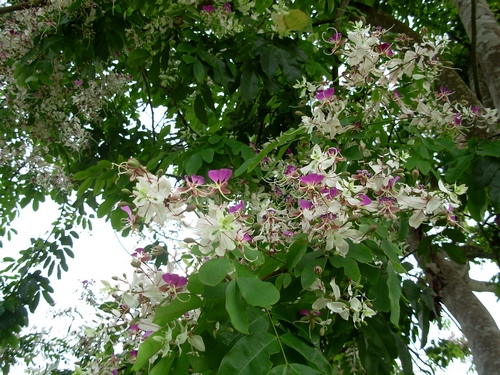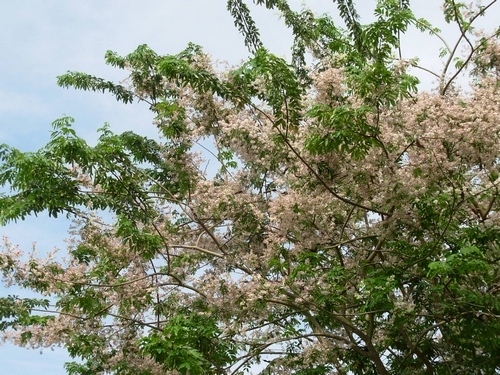Description from
Flora of China
Shrubs or small trees, 2-5 m tall, rarely more than 10 m tall. Petiolules short, 2-3 mm; leaflets oblong or ovate-lanceolate, 5-16 × 2-6.5 cm, papery, lateral veins subparallel, slender, evident on both surfaces, base rounded, apex caudate-acuminate. Panicles 20-40 cm; rachis, bracts, and bracteoles sparsely puberulent; bracts and bracteoles pink, ovate-oblong or elliptic, bracts 1.2-2.8 × 0.5-1.4 cm, bracteoles small, 2-5 mm. Calyx tube 1.2-1.5 cm, much longer than lobes (8-10 mm); lobes dark purplish red, oblong. Petals purplish red, broadly obovate, ca. 1.2 cm including claw, apex rounded, emarginate. Anthers ca. 4 mm; staminodes usually 4, subulate. Ovary hairy, 6-9-ovuled; style slender, hairy. Legume obovoid-oblong, 12-20 cm, sutures unequal in length, ventral suture longer and curved, dehiscent; valves often spirally twisted. Seeds 2-7, brownish red, oblong, 2.2-2.5 × 1.2-1.5 cm, margin not thickened; testa thinner and fragile, surface slightly wrinkled, inside without gelatin. Fl. Jun-Aug, fr. Sep-Nov. 2n = 24*.
The roots, stems, and leaves are somewhat toxic. They are used medicinally to relieve pain from rheumatism and arthritis and for detumescence.
Mountain slopes, jungles, among bushes, near roads, along valleys by streams; below 500 m. Guangdong, Guangxi (Longzhou), Guizhou, Yunnan [Vietnam; introduced in tropical Africa, the Caribbean, Central America, and United States (Florida)].


